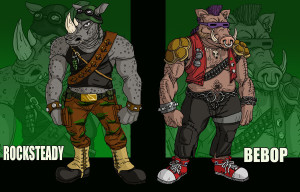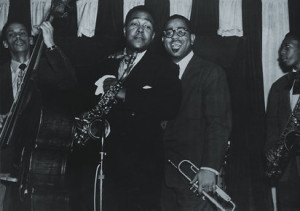Rocksteady and Bebop: Musical styles of the Teenage Mutant Ninja Turtle universe
12/29/2015
Heroes are only as valiant as their opponent is evil. Could you imagine if Magneto was a pushover? The X-Men wouldn’t be nearly as cool if they could easily best their arch enemy. In the TMNT world, Shredder is the king shit villain. He always gives the fearsome foursome a run for their money, but the turtles somehow manage to win.
The TMNT universe is, by design, somewhat of a campy world. That may be why it is so popular with each new generation of kids. There is something very relatable about four close-knit brothers who come up in a strange and foreign world that doesn’t accept them. Imagination is allowed to run wild and it makes perfect sense that a skilled ninja rat, Splinter, would be their father. When the boundaries that confine creative thought are struck down with the logic of, “no one told us we couldn’t do that,” great things can happen.
 Back to the villains. Evil also has a hierarchy as well, and if Shredder is the Alpha, he needs Betas, Charlies, and Deltas to support his power. Enter two of the TMNT’s most beloved bad guys; Rocksteady and Bebop. These mutant cyber-neon punk characters are Shredder’s goofball henchman. They fumble their way through one botched attempt after another when they try to stop those valiant ninja turtles. In the process, they have endeared themselves to the fans across the decades.
Back to the villains. Evil also has a hierarchy as well, and if Shredder is the Alpha, he needs Betas, Charlies, and Deltas to support his power. Enter two of the TMNT’s most beloved bad guys; Rocksteady and Bebop. These mutant cyber-neon punk characters are Shredder’s goofball henchman. They fumble their way through one botched attempt after another when they try to stop those valiant ninja turtles. In the process, they have endeared themselves to the fans across the decades.
Their names, Rocksteady and Bebop, fit them perfectly, but some readers may not know that these are actually musical genres. Both styles of music are unique and have respected artists who have defined them. While many people know that jazz is a style of music, they may have never heard of the sub-genre, “bebop.” Same goes for Rocksteady; people the world over know sun saturated sounds of Jamaican reggae, but don’t know the subtle differences in its precursor “rocksteady.” Slickster Magazine goes into a little deeper musicology for the Teenage Mutant Ninja Turtles’ iconic foes.
(Editor’s note: The musicological term ‘tempo’ is used frequently within. Tempo is the speed at which music is performed.)

Bebop is style of jazz that was pioneered by the “teacher,” John Birks “Dizzy” Gillespie, and the “master,” Charlie “Bird” Parker. Jazz, and therefore bebop, is the only uniquely American art form. Created in the United States, it drew from the rhythms and cultures of Africa and combined them with French marching band instruments. The linear elements of African rhythm meshed with the vertical elements of European harmony and was wholly defined by the African American experience in the antebellum era.
It is important to stress the fact that this is an African American art form, created and innovated by predominantly black men and women. Not to exclude the thousands of white musicians, composers, and music business individuals who participated in and around the music. But any discussion of jazz must address the ever-present truth that the very study of jazz is the study of the African American experience and race relations in the United States.
The character of Bebop, when he was in human form and prior to Shredder’s act of using mutagen to transform him into a warthog humanoid, was a black man. In fact, I think Black Nerd would be the perfect choice to portray him in the new movie. (I know it’s already done, and mostly CGI, but seriously…f’off.) It is impossible to know if Eastman and Laird had planned this or if they just decided, “we need a black guy to be Bebop.” Either way, it didn’t really matter as, although his skin may have been darker than his counterpart Rocksteady, he did not have any other stereotypical characteristics of jazz musicians. He had a purple Mohawk for Christ’s sake, and how scary is a bad guy in a beret? (U.S. Special Forces exempt from that comment. Please don’t hurt us.) TMNT costumes have always been creative, however, there is no known record of any jazz musicians donning a purple Mohawk or nose ring during the heyday of bebop.
Located in Harlem, New York, during the late 1940s and 50s, jazz musicians gathered together to play music after-hours for themselves. Bebop is an extreme form of jazz that is not user friendly. It’s too fast or too slow to dance to. Harmonies change rapidly, frequently shifting tonal centers multiple times in a single measure. The aforementioned harmonies stretched the limits of music in their complexity as well, including dense stacks of notes and challenging substitutions. Soloists improvised longer, more brazen and aggressive solos. Charlie “Bird” Parker is considered by many to be the supreme example of this. Bebop is a macho form of music and the proving ground was the bandstand. “Cutting contests” were musical battles where musicians used their “axes” (instruments) to outperform each other. Weak and unskilled musicians were kicked off the stage and shamed. There is even a famous story of this happening to a young Charlie Parker.
Few of the bebop tunes had actual lyrics, and Gillespie might not even name a composition of his. This is how the name “bebop” came to be. Gillespie, always a teacher to the musicians around him, would use nonsense syllables to sing the melodies. Envision a typical exchange like this:
“Hey Diz, what do you want to play?”
“Let’s play, “be did-dy BOP, du BOP, du bidd-dy bop. Du bah de did-dy do bah be bop.”
That might be how Dizzy vocalized the opening of namesake of the tune “Bebop.” Yes, there is actually a tune entitled “Bebop” and it features Gillespe. Listen to the extreme tempo and highly angular melodies as the trumpet and alto saxophone move through the chord changes at a blistering speed. Only dedicated practice and study over years and years can accomplish this feat of musical acrobatics. It needs to be mentioned that were many other tremendous musicians that were involved with “Bebop,” but that is well beyond the scope of this article.
As jazz music is about being in the moment, bebop eventually evolved and newer styles of music came forward: hard bop and modal jazz, with the ensembles of Miles Davis leading the way. While many musicians and educators create their curriculums, no advanced level of study would be complete without a healthy dose of bebop. Regarded widely as one of the most complex and difficult forms of music ever created, bebop is an iconic music style for an iconic TMNT villain.
